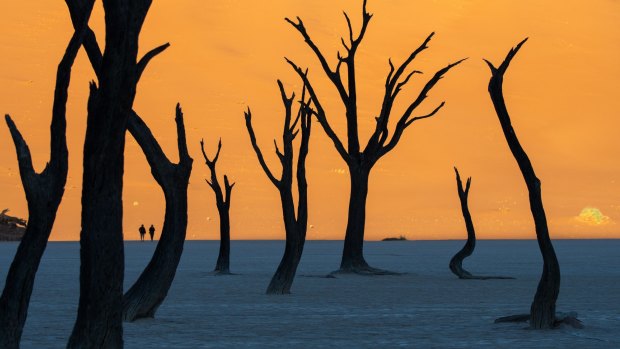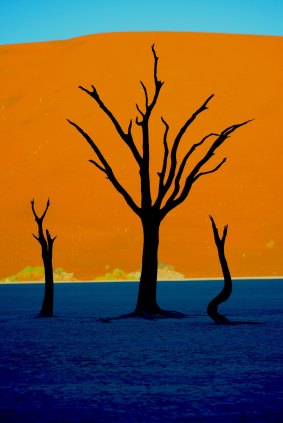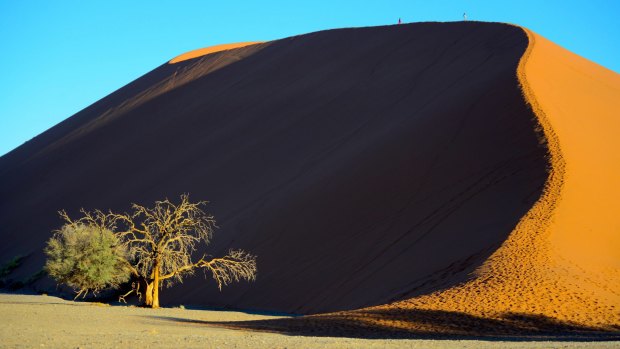This was published 3 years ago
Deadvlei, Namibia: The most photogenic place on Earth, for five minutes a day
By David McGonigal

Arrive at Deadvlei five minutes late and you'll miss the most photogenic scene on Earth.Credit: iStock
The dune isn't very high but as my every step sinks backwards in the sand it seems endless. The sun has risen in a clear eggshell-blue sky and the shadow on the dune opposite is shrinking. If it reaches the base of the dune before I reach my destination then months of planning have been wasted.
The scene is the desert within the Namib-Naukluft Park and my goal is Deadvlei, a salt pan littered with camel-thorn trees that died perhaps 700 years ago. In June 2011 National Geographic published a photograph by Frans Lanting that captured a surreal image of the dead trees of the pan silhouetted against a dune lit by the dawn light while the white of the salt reflected the blue of the desert sky. The photo looked like a painting and attracted 500,000 views in the first two days.

At dawn photos at Deadvlei look like paintings.Credit: David McGonigal
But time is the critical factor. Lanting has stated that "five minutes later when the sun started creeping across the pan the magic had gone". Well, that should be easy: get up early to be there in time. There are two problems in achieving that. The first is that there's a 60-kilometre drive from the entrance to the park and the last five kilometres is definitely 4WD only.
However, the real spoiler is that everyone has to stay at the entrance community of Sesriem and the gates to the National Park don't open until dawn and close at sunset. Inside those gates there is a campground and those who stay there only have to pass through a set of inner gates that open an hour before dawn (and close an hour after sunset). With a widely-ignored park speed limit of 60 kmh, the time frame to be at Deadvlei in time is tight but possible. Inside the second set of gates is the Sossus Dune Lodge that is permitted to take you to the site with plenty of time to spare, however it is often fully booked months ahead. There are many lodges outside the entrance to the park but those who stay there will miss the best times of the day. Of course it's not only photographers who appreciate the wonderful natural lightshow at dawn and dusk.
In the middle of the day there's little point to remaining deep inside the park. It's hot, there's not much shade and it's rather uninteresting. We return to the campground before heading into town. At the gate we have a surreal conversation with a Parks ranger bearing a clipboard.

Deadvlei is a salt pan littered with camel-thorn trees that died perhaps 700 years ago.Credit: evenfh
"So you are departing the park?" he asks.
"Just for an hour or so – we're heading into town for lunch," we reply.
"You must be leaving then," he retorts. "There's no town of Sesriem – just that petrol station." And he points at the Engen fuel pumps 100 metres away.

Sunset over the dunes of Sossusvlei is like a lengthy fireworks display where each moment reveals a new highlight.Credit: David McGonigal
We drive the short distance and buy a packet of matches in the attached store. As we drive back through the gate five minutes later, the ranger waves without getting up.
In the late afternoon we drive back into the park. The sun is low in the sky and as we drive along the flat valley floor the dunes on either side are studies in harsh contrast. Our goal is Dune 45 that stands about 45 kilometres from the gate. At dawn and dusk it attracts crowds who climb the narrow ridge of very soft sand to watch the sun rise or set from its 170-metre summit.
As we drive deeper into the park and long before sunset, shadows cast the dunes into geometric shapes of gold dipped in ink. The dunes here are star-shaped and, from the air, they resemble starfish. They are created by winds that don't come from one predominant direction and tend to grow up rather than out. Each seemed to be trying to outdo each other in sinuous waves extending down to the flat desert floor.
While Deadvlei at dawn is like a symphony that reaches a crescendo then ends, sunset over the dunes of Sossusvlei is like a long fireworks display where each moment reveals a new highlight. Finally, the sun sinks, the dunes are no longer illuminated and it's scenically as flat and uninteresting as it was near noon when there was too much sunlight. Soon the whole landscape is illuminated in pink and lavender alpenglow and before we hit the camp we need to turn headlights on as the stars shine brightly through the clear desert air.
Again we're thankful that we're staying inside the park as those who aren't are limited by the gates closing at sunset. Back at the camp as we prepare dinner, we see unusual eyes gleaming in the dark. The smell of steaks cooking finally brings a small black-backed jackal into the light. He skitters back into the darkness whenever we move and we recall the lady at reception telling us not to leave shoes outside "and they never take a pair but rather one shoe from each pair, just to be difficult".
The following morning produces larger problems than footwear theft. I return for more photography at Deadvlei and it's much more relaxed with knowledge. My photographs were much better, too, as I could refine my compositions from what I did and didn't like from the previous day. My partner elects not to freeze by my side but rather to climb the dune widely known as Big Mamma that's keeping me in the photogenic shade. I see her as a dot on the summit as we both watch a sure-footed Ibex or steenbok elegantly cross the steep side of a dune eating tiny shoots of grass growing through the sand.
Reunited, we elect to drive on two kilometres to Sossusvlei to see Big Daddy that rises more than 300 metres above the valley. Then I unwisely take a sandy shortcut back to the main track. A short steep hill is our undoing and our 4WD Hilux is buried down to its rear axle. Without help we're here for eternity. On foot we retrace our track back to the picnic area and flag down one of the park shuttle vehicles. As if I have an alternative, I ask how much it'll cost to tow us out and the local driver replies "it depends how stuck you are". I tell him we're pretty bogged and he quotes a figure in Namibian that equates to $50. I accept with gratitude. Humiliatingly, we have to mobilise his passengers, a mix of Australians and New Zealanders, to rock the van while he tows and I drive. A few minutes later our van is extricated and I discover I'll be the butt of a lot of trans-Tasman humour for the remainder of their trip.
We leave the remarkable sandscape behind as we have a flight out of Windhoek the following day. It's a 400-kilometre drive and only the first 60 in the park and the last 90 kilometres into the capital are paved. Apart from the sometimes rough road, travel in Namibia is so easy that it's Africa for beginners. In this sparsely-populated country, self-contained rooftop camping is the ideal way to travel. Apart from the camp jackal and the ibex on the dunes, we've encountered ostrich, springbok and warthogs.
As we take in the dramatic view to the west from the top of Spreetshoogte Pass, our next Namibian journey is forming in our minds. It would be three weeks in a 4WD camper but this time we'll aim for the wildlife spectacle of Etosha National Park then the Skeleton Coast. And we'll have to return for another dose of the ethereal peace of Deadvlei where the spirit of trees dead for centuries lives on.
DETAILS
MORE
FLY
Australia's borders are now closed under the federal government's COVID-19 restrictions. You can only leave the country after obtaining special permission from Border Force.
Qantas and South African Airways previously flew to Johannesburg to connect to regular flights to Windhoek, the capital of Namibia. Recommencement of these routes is yet to be announced. See qantas.com and flysaa.com.
DRIVE
Only about 15 per cent of Namibia's roads are paved – the rest are dirt, gravel or sand. So it's best to rent a 4WD. Many simply rent 4WDs fitted with sturdy rooftop tents. Ours was rented from Africa on Wheels fully equipped for about $150 per day including comprehensive insurance, low season. See africa-on-wheels.com
STAY
In Windhoek, either side of the desert, we stayed at the Hilton. See https://www3.hilton.com/en/hotels/namibia/hilton-windhoek-WDHHIHI/index.html
At Sesriem we stayed inside the park gates at the Namibia Wildlife Resorts (NWR) camp. See nwrnamibia.com.
The only other accommodation inside the park is NWR's Sossus Dunes Lodge. See nwr.com.na/resorts/sossus-dune-lodge
The writer travelled at his own expense.
Sign up for the Traveller Deals newsletter
Get exclusive travel deals delivered straight to your inbox. Sign up now.